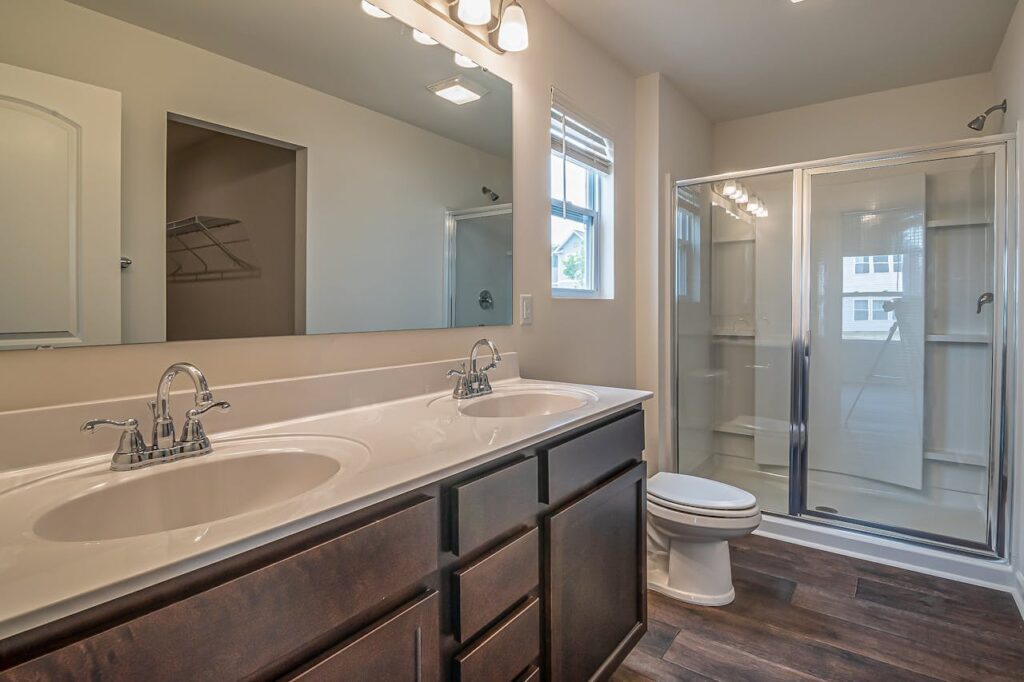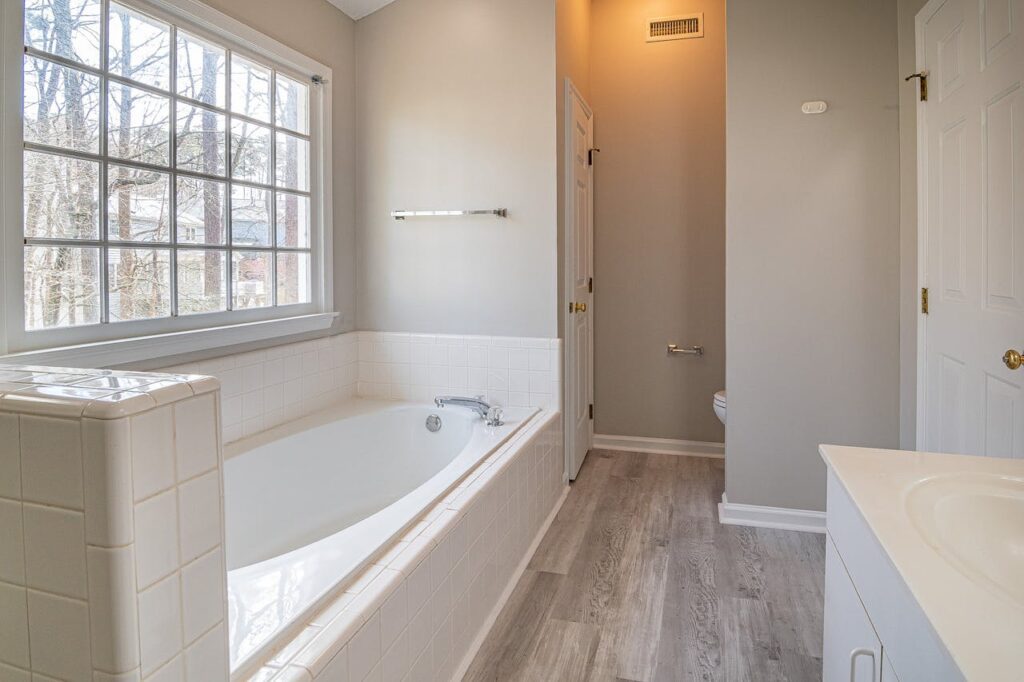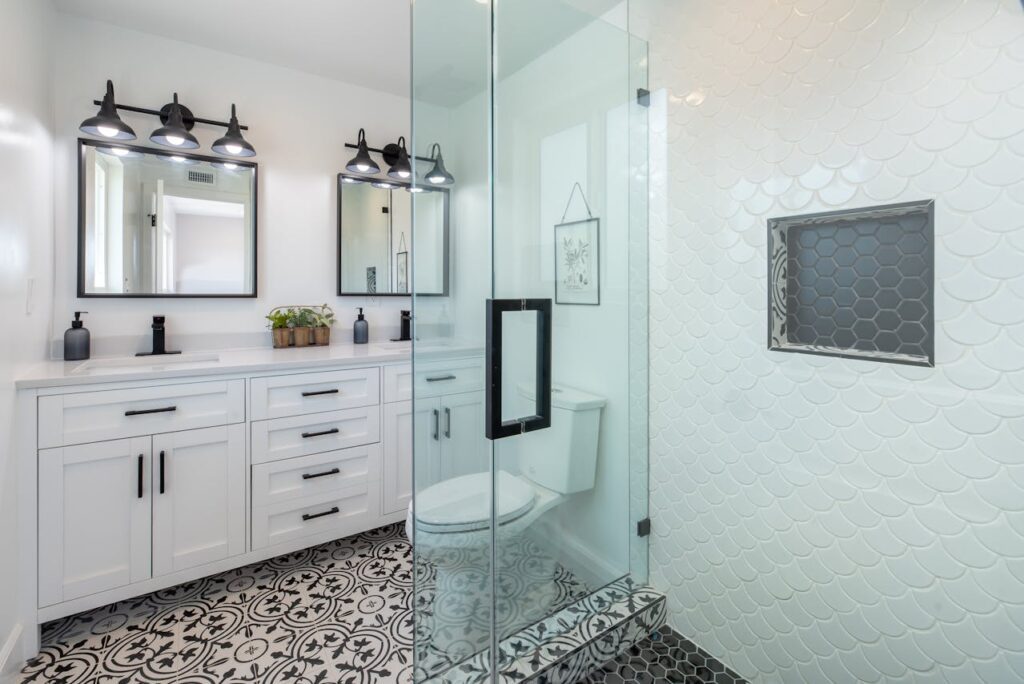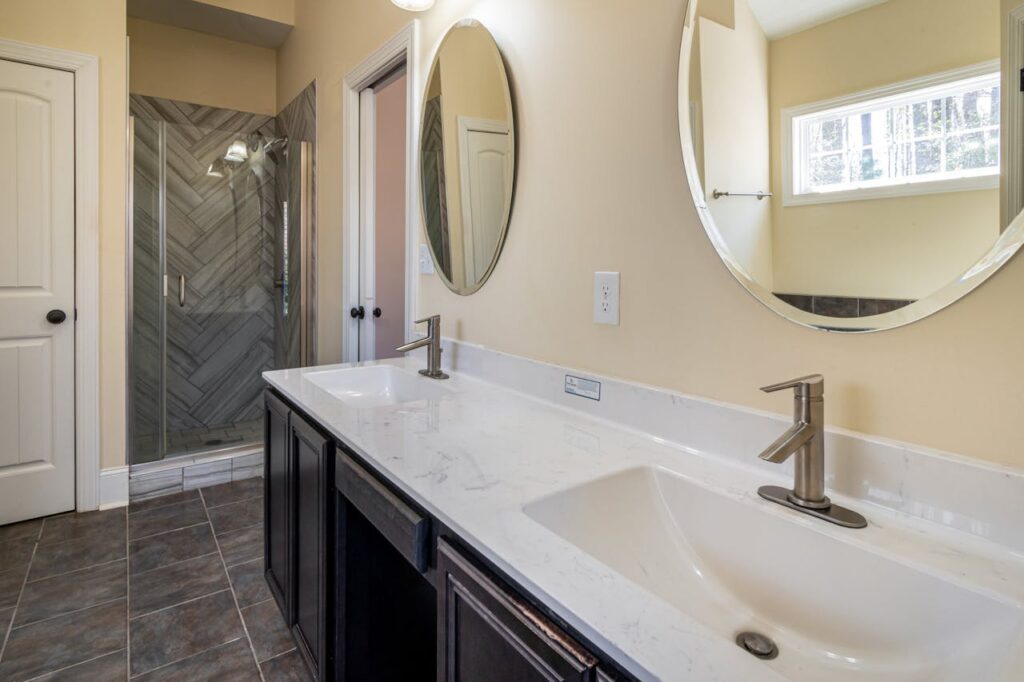Choosing between ceramic and porcelain tiles for your bathroom flooring can be a tough decision. Both options offer durability, water resistance, and a variety of styles to suit your taste. Understanding the key differences and benefits of each type is crucial in making the right choice for your space. Ceramic tiles have been a popular choice for centuries, known for their affordability and versatility. On the other hand, porcelain tiles are highly durable and less porous, making them ideal for high-moisture areas like bathrooms. To help you decide which option is best for you, let’s explore the characteristics and features of both ceramic and porcelain tiles.
Understanding Bathroom Tile Options
Handmade Tile
Handmade tiles offer a unique charm with their irregular edges and variations in color and texture. They are crafted by hand, providing a bespoke touch to your bathroom flooring. Their artisanal quality adds character to the space, creating a one-of-a-kind look.
Handmade Tile:
- Unique charm with irregular edges
- Artisanal quality for a bespoke touch
Ceramic Subway Tile
Ceramic subway tiles are a classic choice for bathroom flooring. Their sleek, rectangular shape and glossy finish add a timeless appeal to any bathroom. They are easy to clean and maintain, making them a practical option for busy households.
Ceramic Subway Tile:
- Classic choice with timeless appeal
- Easy to clean and maintain
Importance Of Process
When selecting bathroom tiles, it’s essential to consider the manufacturing process. The production method impacts the tile’s durability and quality. Handmade tiles undergo a meticulous crafting process, ensuring each piece is unique. On the other hand, ceramic subway tiles are mass-produced, guaranteeing consistency in size and shape.
Importance Of Process:
- Production method affects the durability
- Handmade tiles are unique; ceramic subway tiles are consistent
Impact Of Size And Layout
The size and layout of bathroom tiles play a crucial role in the overall aesthetics and functionality of the space. Larger tiles can create an illusion of spaciousness, while smaller tiles allow for intricate patterns and designs. The layout, whether linear or herringbone, can enhance the visual appeal of the bathroom.
Impact Of Size And Layout:
- Larger tiles create spaciousness
- Smaller tiles enable intricate designs
- Layout enhances the visual appeal
Overview Of Ceramic Tiles
Affordability
Ceramic tiles are affordable and remain a top choice for budget-conscious homeowners looking to renovate their bathrooms. The cost-effectiveness of ceramic tiles makes them an attractive option for those seeking durability without breaking the bank.
Variety
Colors and patterns in ceramic tiles offer a wide range of choices, allowing homeowners to personalize their bathroom design. From subtle neutrals to bold hues, ceramic tiles provide endless possibilities to create a unique and stylish space.
Installation And Cutting
The ease of installation and cutting of ceramic tiles make them ideal for DIY projects. Homeowners can easily tackle bathroom renovations themselves, saving on installation costs. The straightforward nature of working with ceramic tiles adds convenience to the remodeling process.
Overview Of Porcelain Tiles
Durability
Porcelain tiles are renowned for their superior durability, making them perfect for areas with high foot traffic. Unlike ceramic tiles, porcelain tiles are denser and less porous, ensuring longevity and resistance to wear and tear. This durability factor is a significant advantage, especially in bathrooms where frequent use can take a toll on flooring.
Water Absorption
One key feature that sets porcelain tiles apart is their low water absorption rate. This characteristic makes them an excellent choice for wet environments like bathrooms. The low porosity of porcelain tiles prevents water from seeping through, reducing the risk of mold, mildew, and water damage. This quality is crucial in maintaining a clean and hygienic bathroom space.
Aesthetic Versatility
Porcelain tiles offer a wide range of design options, including stylish patterns and collections that cater to various aesthetics. From sleek modern designs to intricate traditional patterns, porcelain tiles provide homeowners with endless possibilities to create their desired look. The availability of high-end finishes and textures adds a touch of luxury to any bathroom setting.
Key Differences Between Ceramic And Porcelain
Manufacturing Processes
Porcelain tiles are made from a more refined and purified clay compared to ceramic tiles. The density of porcelain tiles is higher due to the finer clay used in their production process. These tiles undergo firing at much higher temperatures, typically around 1200-1400 degrees Celsius, which contributes to their durability.
On the other hand, ceramic tiles are crafted from a mixture of clays, sand, and other natural materials. They are fired at lower temperatures ranging from 900-1100 degrees Celsius. This variance in manufacturing processes results in differences in the final products’ strength and performance.
Certification Standards By ASTM
When it comes to quality assurance, the American Society for Testing and Materials (ASTM) has established specific certification standards for porcelain tiles. These standards focus on various aspects such as water absorption rates, breaking strength, and chemical resistance. By meeting these criteria, porcelain tiles ensure longevity and reliability in diverse applications.
Visual Characteristics
In terms of visual appeal, porcelain tiles exhibit a more consistent color and finish compared to ceramic tiles. The uniformity in appearance of porcelain tiles is attributed to their composition and manufacturing process. This consistency makes them ideal for achieving a sleek and modern look in bathrooms or any other space where aesthetics play a crucial role.
When it comes to ceramic tiles, variations in color and finish are more common due to the nature of the materials used and the firing process. While this can add a unique touch to the design, it may also present challenges in achieving a cohesive look throughout the installation.

Durability Considerations For Bathrooms
Wear Resistance
Porcelain tiles exhibit exceptional wear resistance compared to ceramic tiles, making them ideal for high-traffic and moisture-prone areas like bathrooms. The dense composition of porcelain renders it highly durable against scratches and stains.
When exposed to moisture, ceramic tiles tend to absorb more water than porcelain tiles, leading to potential issues such as cracking and mold growth. Porcelain’s low water absorption rate ensures its longevity in wet environments, offering superior protection against water damage.
Application Suitability
For bathroom floors, porcelain tiles stand out as the preferred choice due to their superior durability and water resistance. They can withstand the daily wear and tear of bathroom usage while maintaining their aesthetic appeal over time. On the other hand, ceramic tiles are more suitable for bathroom walls, where water exposure is limited.
Pros Of Porcelain Tiles:
- High durability
- Excellent water resistance
- Low maintenance requirements
Cons Of Ceramic Tiles:
- Higher water absorption
- Prone to cracks in moist environments
Cost Considerations
While porcelain tiles generally come at a higher price point than ceramic tiles, their long-term durability and minimal maintenance needs make them a cost-effective choice for bathroom flooring. Investing in porcelain tiles upfront can save you money on repairs and replacements in the future.
Installation Tips For Tile Flooring
Specialized Tools
When installing ceramic tile or porcelain tile flooring, it is crucial to utilize specialized tools for cutting porcelain tiles. Due to their strength and density, porcelain tiles require specific equipment such as a wet saw to ensure precise cuts and avoid breakage during installation.
Proper substrate preparation is essential before laying down tile flooring in bathrooms. By ensuring the substrate is well-prepared, you can create a level and stable foundation for the tiles. This preparation involves cleaning the surface, removing any debris, and repairing any cracks or uneven areas to prevent future issues with the flooring.
Manufacturer Guidelines
To achieve optimal results with your traditional floor tile installation, it is recommended to follow the manufacturer’s guidelines diligently. These guidelines provide detailed instructions on the installation process, including the type of adhesive to use, proper spacing between tiles, and recommended grouting techniques. Adhering to these guidelines can help maximize the performance and longevity of your tile flooring.
- Use specialized tools for cutting porcelain tiles
- Properly prepare the substrate for a level foundation
- Follow manufacturer guidelines for installation
Cleaning And Maintenance Of Tiles
Maintenance Practices
To maintain the appearance of floor tiles in bathrooms, regular cleaning is essential. For ceramic tiles, use a mild detergent and water solution to remove dirt and grime. Porcelain tiles, on the other hand, can withstand harsher cleaning agents due to their non-porous nature.
Regular sweeping or vacuuming can prevent dirt buildup on both types of tiles. Using a damp mop with a neutral pH cleaner helps preserve the shine of the tiles without causing damage.
Difference In Cleaning Methods
When it comes to cleaning porous ceramic tiles versus non-porous porcelain tiles, the approach varies. Ceramic tiles require more gentle cleaning to avoid damaging the porous surface. Using acidic cleaners can erode the surface of ceramic tiles over time.
For porcelain tiles, harsher cleaning agents can be used to tackle tough stains without causing harm. Their non-porous nature makes them more resistant to staining and easier to clean compared to ceramic tiles.
Sealing Grout Lines
Sealing grout lines regularly is crucial for preventing staining and maintaining the durability of tile surfaces. Grout is highly susceptible to moisture and stains, making it essential to apply a sealer every few years.
Aesthetic Choices For Bathroom Tiles
Design Themes
When it comes to choosing bathroom tiles, both ceramic and porcelain offer a wide array of design possibilities. Handmade tiles can bring a unique touch, while natural stone tiles exude elegance. Consider incorporating various design themes such as modern, rustic, or minimalist to suit your style preferences.
Tile Size And Layout
The size and layout of bathroom tiles play a crucial role in enhancing the overall aesthetic appeal of the space. Opting for larger tiles can create an illusion of a more spacious bathroom, while smaller tiles can add intricate detail to the design. Experiment with different layouts like herringbone or basket weave patterns to elevate the visual interest of the bathroom.
Color And Texture Contrasts
Introducing contrasting colors and textures can transform a mundane bathroom into a captivating oasis. Pairing light-colored tiles with dark grout can make the tiles pop and highlight the intricate details. Mixing glossy and matte finishes can add depth and dimension to the space, creating a visually appealing environment.
Summary
After exploring the differences between ceramic and porcelain tiles for your bathroom, you now have a clearer understanding of which option suits your needs best. Consider the durability, installation process, maintenance requirements, and aesthetic preferences when making your decision. Remember to prioritize functionality without compromising on style to ensure a long-lasting and visually appealing bathroom floor.
When you’re ready to upgrade your bathroom flooring, use the knowledge gained here to make an informed choice. Whether you opt for the classic appeal of ceramic or the enhanced durability of porcelain, your decision will impact both the look and functionality of your space. Take the time to assess your priorities and select the tile that aligns best with your requirements.
Elevate Your Bathroom with Red White & Blue Construction!
Dreaming of a stunning bathroom upgrade? Let’s make it a reality with the perfect tile flooring solution! At Red White & Blue Construction, we’re not just installing tiles—we’re transforming your bathroom in Lafayette, CA, into a luxurious retreat you’ll love. From sleek, modern designs to timeless classics, every tile is expertly placed to create a space that’s as durable as it is beautiful.
Imagine stepping into a bathroom where the tile floor enhances both comfort and style. With our cutting-edge techniques and eye for detail, we ensure your flooring not only looks fantastic but stands the test of time. Whether you’re looking for a bold statement or a subtle elegance, we offer innovative tile options to suit your taste.
At Red White & Blue Construction, we’re known throughout the Bay Area for delivering excellence. Our commitment to quality, transparent pricing, and hands-on client engagement makes the remodeling process exciting and stress-free. You’re not just upgrading a bathroom—you’re reimagining your home’s potential!
Let’s turn your bathroom into the serene, stylish space you deserve. Choose Red White & Blue Construction for tile flooring that sets the foundation for years of beauty and functionality. Transform Your Bathroom with Us—Get in Touch Today!
Disclaimer
The materials available on this website are for informational and entertainment purposes only and not to provide advice. You should obtain advice concerning any particular issue or problem from a professional. You should not act or refrain from acting based on any content included in this site without seeking legal or other professional advice. The information presented on this website may not reflect the most current building developments. No action should be taken in reliance on the information on this website. We disclaim all liability concerning actions taken or not taken based on any or all of the contents of this site to the fullest extent permitted by law.





